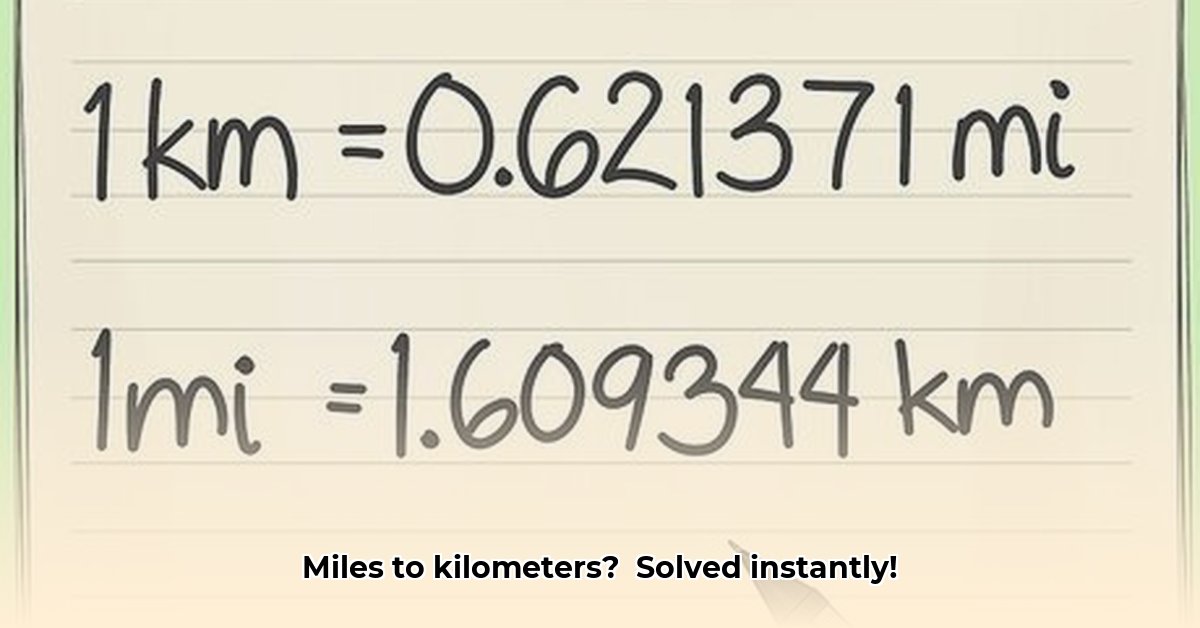
Understanding Kilometer to Mile Conversions: A Global Perspective
Ever wondered about the difference between kilometers and miles? These units, both measuring distance, are prevalent in different parts of the world, leading to occasional confusion. The United States uses miles predominantly, while the majority of the globe utilizes kilometers. This seemingly simple difference has significant implications in various fields including travel, international trade, and even sports. Understanding how to convert between these units is becoming increasingly crucial in our interconnected world. This guide will provide a clear and comprehensive approach to mastering kilometer to mile conversions—from simple calculations to using online tools and understanding the nuances of accuracy. For a quick reference, check out this helpful mile to kilometer converter.
The Conversion Factor: Cracking the Code
The core of kilometer to mile conversions lies in a simple yet powerful mathematical relationship. One kilometer is approximately equal to 0.621371 miles. This means a mile is longer than a kilometer. To visualize this, imagine that a mile is a bit more than stepping 1.6 kilometers. This seemingly small difference significantly impacts calculations, especially over long distances.
Manual Conversion: A Step-by-Step Approach
Let's delve into the process of converting kilometers to miles manually. This method is straightforward and enhances your understanding of the conversion:
Step 1: Identify the Kilometer Value. Let's use 150 kilometers as an example.
Step 2: Apply the Conversion Factor. Multiply the kilometer value by 0.621371: 150 km * 0.621371 mi/km = 93.20565 miles.
Step 3: Round (Optional). For most purposes, rounding to the nearest tenth of a mile (93.2 miles) is sufficient. However, for situations demanding higher accuracy, such as scientific calculations or navigation systems, maintain more decimal places.
Quick Estimation Tip: For a rough estimate, multiplying the kilometer value by 0.6 provides a reasonably close approximation. This is particularly useful for mental calculations.
Your Handy Kilometer to Mile Conversion Chart
While manual calculation offers a thorough understanding, a conversion chart serves as a quick reference:
| Kilometers | Miles (Approximate) | Miles (Precise) |
|---|---|---|
| 1 | 0.6 | 0.621371 |
| 5 | 3.1 | 3.106855 |
| 10 | 6.2 | 6.21371 |
| 25 | 15.5 | 15.534275 |
| 50 | 31 | 31.06855 |
| 100 | 62 | 62.1371 |
| 200 | 124 | 124.2742 |
| 500 | 310 | 310.6855 |
| 1000 | 621 | 621.371 |
Use the "Approximate" column for quick estimations and the "Precise" column for applications requiring greater accuracy.
Leveraging Online Converters: Convenience at Your Fingertips
Numerous online converters simplify the process. These tools instantly convert kilometers to miles, eliminating the need for manual calculations. They are invaluable for quick conversions and are readily available on various websites and mobile apps. This method prioritizes speed and convenience. However, remember that the accuracy depends on the reliability of the converter used. Always opt for trusted and well-established tools.
Real-World Applications: Beyond Simple Conversions
The ability to convert kilometers to miles extends far beyond simple calculations. It's essential in various areas:
- Travel Planning: Accurately determining distances for road trips, flights, and other modes of transportation.
- International Trade: Calculating transportation costs and delivery times based on distances between locations.
- Sports: Comparing athletic performances across different countries and using different measurement systems.
- Mapping and Navigation: Interpreting distances on maps and utilizing GPS systems effectively.
A Brief History: Why Two Systems?
The existence of both miles and kilometers reflects differing historical measurement systems. The use of miles originated in the Roman Empire influencing most of the Western world, while the metric system, with kilometers as its unit for distance, was developed in France and later adopted globally. Understanding this historical context enhances our comprehension of the current usage of these distinct systems.
Conclusion: Embracing Global Measurement
Mastering kilometer-to-mile conversion is increasingly important in our interconnected world. Whether you use manual calculation, online converters, or approximation techniques, understanding the conversion factor empowers you to navigate global distances effectively and efficiently. This simple skill enhances accuracy in travel planning, international trade, sports analysis, and many other fields.